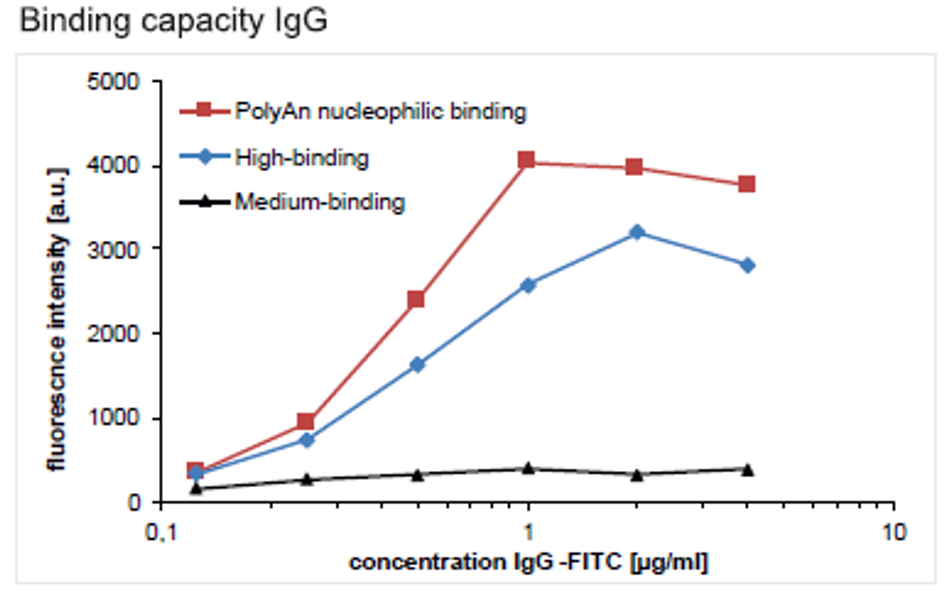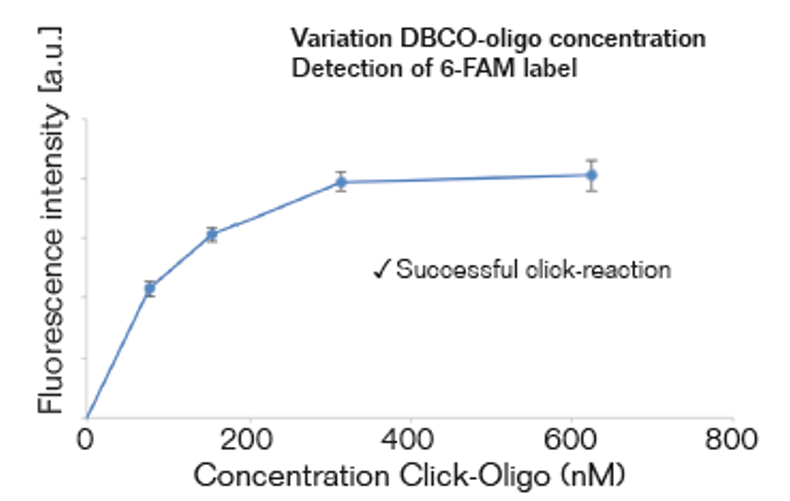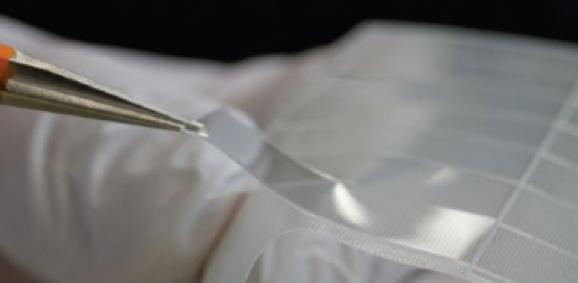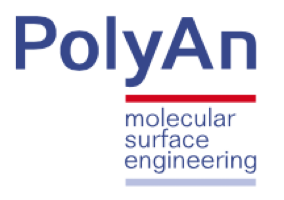We carry the full line of PolyAn‘s microarray products, consisting of functionalized slides, coverslips, microtiter plates, films, and membranes. This is one of the broadest range of surfaces for the immobilization of biomolecules. Combined with M2 Automation spotters, you can now produce very high quality microarrays in your own lab.
PolyAn’s 3D-functionalised microarray Slides are functionalized with a three-dimensional (3D)-surface chemistry comprised of a long-chain polymer containing a defined number of reactive groups. This polymer is covalently linked to the surface of the coverslip.
PolyAn microarray products’ MSE-technology gently binds the functional layer onto the surface without damaging the base substrate. The morphology of the functional surface and thus the number of the reactive groups can be fine-tuned within a narrow range. This yields a number of advantages:
- Low fluorescence background. Covalent binding of functional layer on the substrate without changing the initial autofluorescence.
- Low unspecific binding. Combination of reactive functional groups with PolyAn antifouling matrix.
- Topography Tuneable surface hydrophilicity / hydrophobicity (contact angle).
- Uniform spot morphology. Narrow variation of surface properties and homogeneous distribution of reactive groups.
- Optimal density and high accessibility of reactive groups. Morphology and thickness of functional layer tailored to the desired application.

Microarray Slides & Coverslips
Functionalization Methods
Epoxy and NHS Surfaces
The surfaces are often used the covalent immobilization of biomolecules.
Nucleophilic groups on the biomolecule, such as amino, thiols, and hydroxyl, react with the epoxy group on the surface to form a covalent bond.
In the case of PolyAn’s 3d-epoxyand 3D-NHS surfaces, the surface is uncharged and integrates a low fouling matrix.
As shown on the graph, such a 3d-epoxy surface allows for a higher amount of immobilized proteins per unit area, as compared to passive/adsorptive binding surfaces.



Azide Surfaces
The surfaces are often used the covalent immobilization of oligo nucleotides.
The binding uses simple coupling chemistry of a highly specific bio-orthogonal reaction.
This is an alternative to the conventional Streptavidin-Biotin immobilizatipn approach.


2D-functionalized Glass Slides
For cost-sensitive applications PolyAn microarray products include a range of 2D (2-dimensional)-reactive glass slides that are manufactured from high quality glass with an ultra-flat surface and low inherent fluorescence. The glass is coated with a thin silane layer that will covalently bind most types of bio-molecules. The defect-free surface features uniform silane layers that provide a high covalent coupling efficiency together with a very low background. The slides are easy to use, and are fully compatible with all commercially available arraying and scanning instruments. The glass slides are 25.0 x 75.6 mm and are available as 5- or 25-packs.
| ID | Surface |
|---|---|
| 104 00 021 | 2D-Amino |
| 104 00 121 | 2D-Carboxy |
| 104 00 221 | 2D-Epoxy |
| 104 00 321 | 2D-Aldeyde |
| 104 00 421 | 2D-NHS |
| 104 00 521 | 2D-Thiol |
| 104 00 621 | 2D-Azide |
| 104 01 321 | 2D-PDITC |
3D-functionalized Glass Slides
PolyAn’s functionalized slides for microarrays are functionalized with a three-dimensional (3D)-surface chemistry comprised of a long-chain polymer containing a defined number of reactive groups. This polymer is covalently linked to the surface of the slide. The glass slides are 25.0 x 75.6 mm and are available as 5- or 25-packs.
Packaging: The slides are packaged in inert atmospheric boxes, with a capacity of 25 or 5 slides per box.
Storage: PolyAn’s slides are characterized by a long shelf-life when stored dry, at 4-8°C and protected from sunlight. All slides are packaged in boxes under Argon atmosphere to avoid contamination with particles. The Argon atmosphere also minimizes degradation of the reactive surface through contact with air or humidity.
| ID | Surface |
|---|---|
| 104 00 001 | 3D-Amino |
| 104 00 101 | 3D-Carboxy |
| 104 00 201 | 3D-Epoxy |
| 104 00 301 | 3D-Aldeyde |
| 104 00 401 | 3D-NHS |
| 104 00 402 | 3D-NHS (hydrophilic) |
| 104 00 501 | 3D-Thiol |
| 104 01 201 | Poly-L-Lysin (covalently coated) |
| 104 01 301 | 3D-PDITC (activated amino) |
| 104 01 401 | 3D-Maleimide |
| 104 02 205 | Streptavidin (covalently coated) |
| 104 03 205 | Neutravidin (covalently coated) |
| 104 04 205 | Avidin (covalently coated) |
Functionalized Polymer Slides
Especially for diagnostic applications, PolyAn microarray products include a broad range of functionalized microarray polymer slides. For reasons of reliability and bio-safety, patient-centric biomarker testing is always performed in single-use cartridges with a one-step process (sample in – result out). These cartridges should be disposable after use, so the materials of the cartridge should be non-hazardous and recyclable.
PolyAn’s COP Polymer Slides are comprised of a low auto fluorescence plastic. The material is highly robust against breakage making it the material of choice when working with hazardous materials. It is suitable for injection molding and hot embossing processes.
The slides are produced with standard dimensions of 25 x 75 x 1 mm.

| ID | Surface |
|---|---|
| 104 00 051 | 3D-Amino |
| 104 00 151 | 3D-Carboxy |
| 104 00 251 | 3D-Epoxy |
| 104 00 351 | 3D-Aldeyde |
| 104 00 451 | 3D-NHS |
| 104 00 551 | 3D-Thiol |
| 104 01 251 | Poly-L-Lysin (covalently coated) |
| 104 01 351 | 3D-PDITC |
| 104 01 451 | 3D-Maleimide |
| 104 02 255 | Streptavidin (covalently coated) |
| 104 03 255 | Neutravidin (covalently coated) |
| 104 04 255 | Avidin (covalently coated) |
2D-Functionalized Coverslips
For high-resolution microscopic imaging or scanning applications PolyAn offers functionalized coverslips. All of PolyAn’s standard functional coatings can also be applied to coverslip glass.
All coverslips have the standard dimension of 25 x 60mm. Type #1.5 is used as a standard thickness. All coverslips are packed in boxes of 5. Other functionalities, thicknesses and sizes are available upon request. PolyAn also offers functionalised substrates that are coated with gold or other noble metals as well as waveguide materials.
| ID | Surface |
|---|---|
| 104 00 026 | 2D-Amino |
| 104 00 126 | 2D-Carboxy |
| 104 00 226 | 2D-Epoxy |
| 104 00 326 | 2D-Aldeyde |
| 104 00 526 | 2D-Thiol |
| 104 00 626 | 2D-Azide |
3D-Functionalized Coverslips
.
| ID | Surface |
|---|---|
| 104 00 006 | 3D-Amino |
| 104 00 106 | 3D-Carboxy |
| 104 00 206 | 3D-Epoxy |
| 104 00 306 | 3D-Aldeyde |
| 104 00 407 | 3D-NHS |
| 104 00 506 | 3D-Thiol |
| 104 01 206 | Poly-L-Lysin (covalently coated) |
| 104 01 306 | 3D-PDITC (activated amino) |
| 104 02 206 | 3D-Maleimide |
| 104 02 206 | Streptavidin (covalently coated) |
| 104 03 206 | Neutravidin (covalently coated) |
3D-Functionalized Polymer Films
Functionalized Cyclo Olefin Polymer (COP) films with low autofluorescence that can be easily cut into suitable formats post printing. COP is characterized by a low autofluorescence. The finished film-chip can be easily integrated into cartridges or microfluidic devices.
The sheets are available in slide format (75 mm x 25 mm) as well as larger sheets (75 mm x 110 mm). They are 188 micron thick, and sold as 5 sheets per box. Customized pre-scored sheets are available upon request.
Please download the Application Note “Assembling of spotted, pre-cut COP sensor foil with DNA-microarray on a microfluidic hybridization cartridge” here.
| ID | Surface |
|---|---|
| 104 00 056 | 3D-Amino |
| 104 00 256 | 3D-Epoxy |
| 104 00 456 | 3D-NHS |
Functionalized Microtiter Plates.
In order to take advantage of the existing liquid handling and automation solutions for 96-well and 384-well SBS formats, PolyAn microarray products include a full range of functionalized multiwell products which are equipped with the same reactive surfaces as our glass and plastic slides. Standard polystyrene 96-well and 384-well plates in different designs which are equipped with PolyAn’s reactive matrices for covalent coupling of biomolecules.
Key features:
- Compatible with all liquid handling systems for ELISA
- Covalent binding of nucleophiles to the plate surface without complex coupling chemistry
- Integrated antifouling matrix reduces unspecific binding
- No cross-contamination between wells possible
- Most cost-efficient solution
3D-Functionalized 96-well solid plates
Functionalized plates for microarrays include black polystyrene uClear (from Greiner Bio-One).
| ID | Surface |
|---|---|
| 00 691 251 | 3D-Epoxy |
| 00 691 451 | 3D-NHS |
| 00 791 251 | Streptavidin (covalently coated) |
| 00 792 251 | Neutravidin (covalently coated) |
3D-Functionalized 96-well strip plates
Functionalized plates for microarrays also include strip plates that consists of 12 x 8-well strips, with flat bottom wells. They offer the best flexibility when usage doesn’t always involve using a full plate.
These plates are either white or transparent polystyrene (from Greiner Bio-One).
| ID | Surface |
|---|---|
| 00 680 251 | 3D-Epoxy, white |
| 00 691 451 | 3D-NHS, white |
| 00 681 251 | Streptavidin (covalently coated), white |
| 00 682 251 | Neutravidin (covalently coated), white |
| 00 690 251 | 3D-Epoxy, transparent |
| 00 690 301 | 3D-Aldehyde, transparent |
| 00 690 451 | 3D-NHS, transparent |
| 00 690 601 | 3D-Azide, transparent |
| 00 693 251 | Streptavidin (covalently coated), transparent00 692 251 |
| Neutravidin (covalently coated), transparent |
3D-Functionalized 96-well 2-part plates
Multipart plates consists of a flat bottom and 96-well frame. PolyAn’s multipart plates are comprised of a functionalized glass plate (75 x 110 mm, 1mm thickness) which is combined with the ProPlate superstructure after the printing process.
Products listed include both the glass bottom and the plate frame (round or square wells).
| ID | Surface |
|---|---|
| 00 700 201 | 2D-Amino, round |
| 00 700 001 | 3D-Amino, round |
| 00 700 221 | 2D-Epoxy, round |
| 00 700 251 | 3D-Epoxy, round |
| 00 700 301 | 3D-Aldehyde, round |
| 00 700 451 | 3D-NHS, round |
| 00 705 001 | 3D-Amino, square |
| 00 705 221 | 2D-Epoxy, square |
| 00 705 251 | 3D-Epoxy, square |
| 00 705 301 | 3D-Aldehyde, square |
| 00 705 451 | 3D-NHS, square |
3D-Functionalized 384-well 2-part plates
Multipart plates consists of a flat bottom and 384-well frame. PolyAn’s multipart plates are comprised of a functionalized glass plate (75 x 110 mm, 1mm thickness) which is combined with the ProPlate superstructure after the printing process.
Products listed include both the glass bottom and the plate frame with square wells.
| ID | Surface |
|---|---|
| 00 710 021 | 2D-Amino |
| 00 710 001 | 3D-Amino |
| 00 710 221 | 2D-Epoxy |
| 00 710 251 | 3D-Epoxy |
| 00 710 301 | 3D-Aldehyde |
| 00 710 451 | 3D-NHS |

